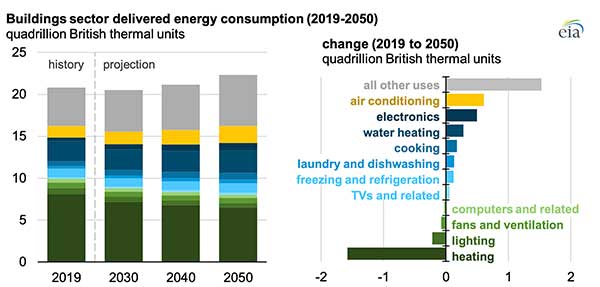EIA projects energy usage shifts in coming decades

EIA projects that from 2019 to 2050, delivered energy consumed for space heating will fall by more than 1.5 quadrillion British thermal units – the largest decline among end uses. Click to enlarge. Chart: U.S. Energy Information Administration, Annual Energy Outlook 2020
In its Annual Energy Outlook 2020 reference case, the U.S. Energy Information Administration (EIA) projects that delivered energy for air conditioning will increase in residential and commercial buildings through 2050, while energy consumption for space heating will decline.
In 2019, space heating accounted for 38 percent of delivered energy in buildings, a larger share than any other end use.
EIA projects that from 2019 to 2050, delivered energy consumed for space heating will fall by more than 1.5 quadrillion British thermal units – the largest decline among end uses.
Total consumption of delivered energy by the buildings sector will increase by 7 percent, as growing demand for air conditioning, electronics and more offsets declines in energy consumption for heating and lighting, according to EIA projections.
While space heating is expected to decline in the coming three decades, EIA expects that water heating, cooking, and laundry and dishwashing – all markets in which propane is an option – will increase.
The projections derive from projected population shifts from colder to warmer parts of the United States, assumptions of warmer weather and regional differences in sector growth, according to EIA.
Across the buildings sector, purchased electricity accounted for 94 percent of delivered energy for air conditioning in 2019. A wider variety of fuels met space heating needs.
Natural gas was by far the most common fuel for space heating, accounting for about 70 percent of energy consumed for space heating in 2019. Smaller shares of wood, distillate, propane and electricity also fuel heating equipment, according to EIA.
Heating degree-days, when temperatures fall below 65 degrees Fahrenheit, have generally declined as temperatures have risen and as the U.S. population has moved to warmer climates.
Meanwhile, cooling degree-days, when average temperatures in a location exceed 65 degrees Fahrenheit, have generally increased, according to EIA.
Based on population-weighted heating and cooling degree-day data from the National Oceanic and Atmospheric Administration and U.S. Census Bureau population data, EIA estimates that in 2019, the United States experienced almost 4,300 weighted heating degree-days and nearly 1,500 cooling degree-days.
The difference between these values explains why more energy is used for space heating than for air conditioning, according to EIA.
EIA expects the difference between weighted heating and cooling degree-days to continue to narrow over time.
Featured image: tttuna/E+/Getty Images
















